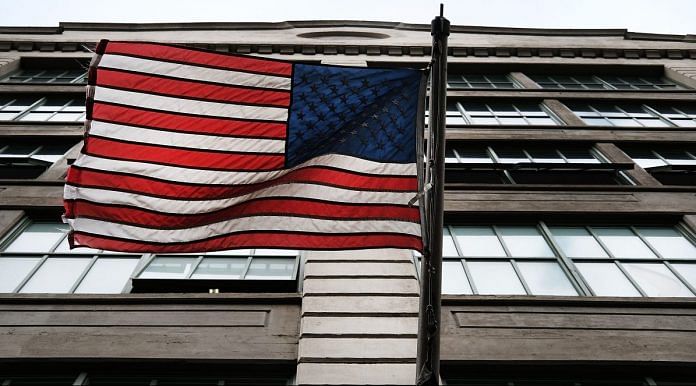The inevitability of going to a trade war has been accepted as ‘predestined’, with the ‘when’ entirely driven by approval rating and domestic quibble.
It seems whenever the US administration has little room to manoeuvre at home, it has historically looked for sideshows abroad. It creates an external crisis, shifts backdrop, so that the public can focus on a new dramatic event.
It was this tactic that contributed to John Kennedy’s increased approval rating after the April 1961 failure of the Bay of Pigs, Lyndon B. Johnson’s rise after the 1965 intervention in the Dominican Republic, and Ronald Reagan’s rise after the 1983 invasion of Grenada.
The public has not only accepted but also expected that foreign nations are changeable backdrops in the theatre of domestic politics.
It is no wonder then that the Trump administration has predicted that a war or a trade war among nations is imminent. What is less comprehensible is the size of the target the administration is willing to pick, and the collective damage that it has implicated the public to endure.
The trade between the United States and China, measured by financial terms, has been unbalanced for years. The United States imported $506 billion worth of goods from China in 2017; China bought approximately $130 billion worth of goods made in America. On Twitter, Trump was quick, though categorically wrong, in saying: “When you’re already $500 Billion DOWN, you can’t lose!” He was wrong not so much because the goods deficit with China is in fact $375.2 billion, or because thinking that China is running out of American goods to slap tariffs on is inaccurate, but he misconstrued how the global economy, and in particular the internet economy, has generated wealth and technological advancement for the United States and for the world.
In 1965, Intel co-founder Gordon Moore made a bold prediction about the exponential growth of computing power. From vacuum tube to discrete transistor to integrated circuit, miniaturisation of computer hardware had rapidly progressed. Extrapolating the trend, Moore asserted that the number of microchip transistors etched into a fixed area of a computer microprocessor would double every two years. Given that transistor density correlated with computing power, the latter would double every two years. Intel has since delivered on that promise and immortalised it as “Moore’s law.”
If Moore’s law were applied to the auto industry, cars would by now get half a million miles per gallon, go 300,000 mph, and be so cheap that drivers simply dump a Rolls-Royce than park it.
What Trump’s administration has misconstrued is the locale of innovation by believing it all begins in the United States. They believe that China, including a large part of Asia, is either a fast follower or copycat who begs, borrows, and steals. It is not.
For example, the central processor of Apple’s iPhone is designed in the United States, but its battery, displays, and most of its other parts are made somewhere else. The iPhone has hundreds of components, approximately 90 per cent of which are produced with the help of workers in Germany, Singapore, South Korea, Taiwan, China, and elsewhere. Manufacturing of the central processor, or semiconductors, happens in three stages—design, wafer fabrication, and assembly. In the 1960s, the United States started to send low-skilled assembly to Asia. Skilled wafer fabrication followed in the 1980s, and within the last decade, some of the most complex design works have also moved overseas, mostly because of the sheer size of engineering talents abroad.
The point is that innovation requires a collaboration between the design team and the factory workers. Today, not just low-skilled jobs are located in Asia; many higher-waged and higher-skilled tasks can also be fulfilled there. For example, TSMC in Taiwan and Samsung in South Korea are the critical component suppliers to IBM, Apple, HP, and Dell.
Indeed, the very fulfilment of Moore’s law hinges upon a global supply chain, and without that globally distributed network of research and development, the very acceleration of computing power would have been all but impossible. There might still be Google but much less prominent, Facebook no more than a college student directory, certainly no Uber or Airbnb or Snapchat. The entire Silicon Valley could well perhaps be just a little wine valley.
I remember attending a start-up pitch night, where entrepreneurs presented their business plan to an audience of investors from the Harvard alumni community in New York. A medical device start-up based in California had just launched a baby monitoring device using imaging technologies to prevent accidental suffocation during sleep. The founding team were all graduate students from MIT who were born in India. Now the team members live in San Francisco, mostly responsible for design and research. The entire supply chain, from early prototyping to manufacturing to packaging to logistics, resides in Shenzhen, China. “They are fast and quick and very flexible. I can’t find anyone prototype my product idea this fast and this cheap in the US,” the thirty-something CEO told me. “I can’t innovate without my counterpart in Asia.”
China, of course, is no Grenada. It was not the Dominican Republic. It was not, as everyone understands, except for the White House it seems, Korea or Vietnam. China is the world’s second largest economy, the largest trading partner for the United States, the biggest international market for American icons such as GM, Ford, GE, Johnson & Johnson, and P&G. Yet, the inevitability of going to a trade war has been accepted as “predestined”, with the “when” entirely driven by approval rating and domestic quibble.
Howard Yu is the Lego Professor of Management and Innovation at the IMD business school in Singapore and Switzerland.
Also read: Trump’s protectionist tariffs not directed at India, but can have a collateral impact






